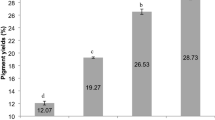Abstract
Pigments of citrus, prune and cucurbit fruit seed oils were studied spectrophotometrically. The citrus fruits used were: orange (O), mandarin (M), bitter orange (BO) and lemon (L). The prunes used were apricot (A), peach (P) and plum (PL); while melon (M), watermelon (WM) and Winter squash (S) were the cucurbits. Absorption spectra and Lovibond color were studied for crude, refined and bleached oils. Cottonseed oil (CSO) was mixed with some of the previous oils in the crude state, then refined and bleached. Absorption spectra of the crude fruit seed oils revealed carotenoid pigments at 400, 425, 455 and 480 nm, chlorophyll at 610 and 670 nm and unknown pigments at 525, 570 and 595 nm. Refining did not remove these pigments, whereas bleaching eliminated them completely. In oil mixtures of CSO+A, CSO+M and CSO+S, interference occurred between gossypol ‘360 nm’ from CSO and the pigments of A, M and S seed oils. Refining the oil mixtures removed gossypol, but its effect on carotenoids, chlorophyll and unknown pigments was limited. Bleaching completely removed all these residual pigments. Lovibond color for all bleached oils was very low (0.2–2 yellow). The refined oils, except those containing Winter squash seed oil, were found to have an acceptable color (0.8–15 yellow). Results of the proposed process reveals the possibility of mixing crude edible oil with crude fruit seed oils, then processing the oil mixture by the conventional methods of refining and bleaching.
Similar content being viewed by others
References
Annual Report, Department of Statistics, Central Undersecretary for Agricultural Economics, Ministry of Agriculture, 1987.
Associated Committee of Food Industry Companies (Edfina, Kaha and Corona) for Purchasing Agricultural Materials, 1987.
Habib, M.A., M.A. Hamman, A.A. Sakr and Y.A. Ashoush,J. Am. Oil Chem. Soc. 63:1192 (1986).
Hallabo, S.A., F.A. El-Wakeil and M.K. Morsi,Egypt. J. Food Sci. 3:1 (1976).
Osman, H.O., Y. G. Moharram and M.R. Bakr, (eds.),Lipid Protein Vegetable Sources, Faculty of Agriculture, University of Alexandria, 1985.
Braddock, R.J., and J.W. Kesterson,Agric. Exp. Station Inst. Food and Agric. Sci., Florida University, Bull. No. 756 (1973).
Cruess, W.V., (ed.),Commercial Fruit and Vegetable Products, McGraw-Hill Publishing Co., NY, 1958.
Helmy, H.E., and Z.E. Shoeb,Seifen. Öle. Fette. Wachse, in press.
Singh, A.K., and K.S. Yadara,Indian J. Agric. Sci. 48: 766 (1978).
Vasconcelles, J.A., and J.W. Berry,J. Am. Oil Chem. Soc. 59: 201 (1982).
Official and Tentative Methods of The American Oil Chemists' Society, 3rd edn., American Oil Chemists' Society, Champaign, IL 61826.
Author information
Authors and Affiliations
About this article
Cite this article
Helmy, H.E. Studies on the pigments of some citrus, prune and cucurbit seed oils when processed with or without cottonseed oil. J Am Oil Chem Soc 67, 376–380 (1990). https://doi.org/10.1007/BF02539694
Received:
Accepted:
Issue Date:
DOI: https://doi.org/10.1007/BF02539694




